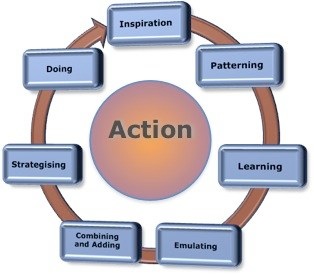Action Steps

The seven action steps are: Inspiration, Patterning, Learning, Emulating, Combining and Adding, Strategising, and Doing. Many people make the mistake of starting out by setting objectives and strategising. You’ll notice that comes towards the end of this process. If you are without a direction, it means you need ideas. Do this by experiencing things that you store away as memory traces. It wont necessarily transform your life, but these experiences will be useful in all of the steps.
Inspiration. literally means to inhale and it suggests the link between action and inspiration. The more you move the more you need to inhale and the more you move the more chances for inspiration. Seek out others’ ideas through meetings, conversations and invitations. Expose yourself to new ideas via other mediums such as books, classes, training, newspapers, magazines and television, internet, theatre, galleries and museums. Choose things that are novel to you, break the routine. The aim here is not directly to “get a job” or even direction. Simply the idea is to be exposed to many different experiences.
Patterning. As you gain new experiences look for the structures, the hidden meanings, the ideas contained within them. How is the experience presented, structured? What does it mean to you? What are the common elements that occur frequently throughout the experience, what are the essential aspects of it? What could be taken away from the experience without it marring your enjoyment?
Learning. Which experiences did you like and which did you not like? Why? What do all the things you like have in common? What do all things you didn’t like have in common? What do you know now that you didn’t know before you embarked on step 1? How could that learning be useful to you?
Emulating. In this step you practice copying and reproducing an activity that you liked. Often trying to do something is a great way of getting a deeper insight into an activity and a good way of testing whether you really are interested in it or not. In business and the arts many successful people never get beyond this stage. For instance in Bangladesh they’ve just built an exact copy of the Taj Mahal, and Melbourne has a wheel like the London Eye.
Combining, Adding and Emerging. At this stage you go beyond copying and create something original and uniquely suited to you or your circumstances. This happens when you make links between things you have learned - your experiences - and other stored experiences to create something new. It is about combining pieces of your jigsaw in a new way to produce a new pattern that you know will work. The more pieces of the jigsaw you collect through experience and learning, the more patterns you can create.
Strategizing. Once you see the new pattern and possibilities you can work on how you are going to get from where you are to where to need to be. This where a lot of the traditional and rational ideas about evaluating alternatives and planning goals fits in.
Doing. Finally you need to act and at the same time go back to stage 1 and cycle through the steps. The model is a dynamic one that is based on the premise that we are continually in a state of both being and becoming.

© Bright and Associates 2016
Beyond Personal Mastery® is a Registered Trademark of Bright and Associates